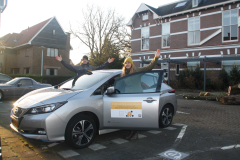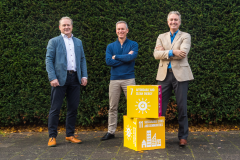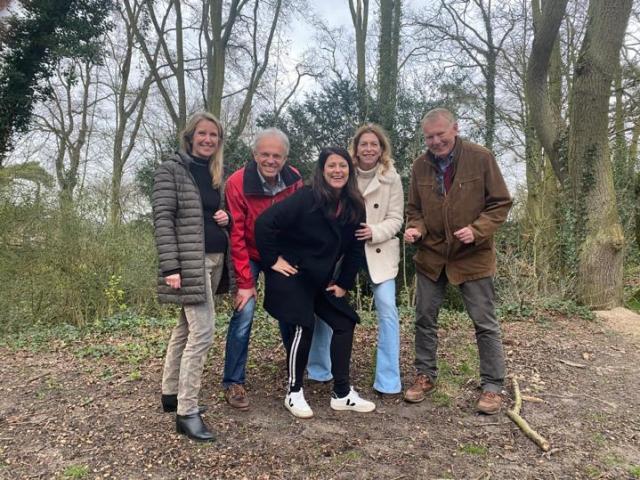Column

The Sustainable Initiative of Niki and Tom
To become carbon neutral, we are working together on sustainable initiatives from the Climate Table. Meet Wassenaarders who are committed to this. Like Niki (32) and Tom (30) van Driel who are happy with the convenience offered by the electric car-sharing service Samen Slim Rijden.
What does this initiative mean to you?
It makes it financially possible for us to drive an electric car. With the shared car we drive to family, friends and sporting events. Now about once every two weeks, normally more often. One of the advantages of not owning the car is that it is not parked at the door unnecessarily. We pay according to usage; this saves costs and is better for the environment.
Why do you think this is important NOW?
We specifically chose an electric share car because of its low environmental impact. Alternative share cars are also available but they run on gasoline instead of electricity. We are quite active in the field of sustainability and would like to show that things can be done differently.
How did you come across this initiative?
Since Wassenaar has no train connection, we looked into buying a car. We came across this through De Wassenaarse krant and then planned a test drive. The ease of use and the fit with our ideas on sustainability made us decide not to buy a car, but to share. Put your money where your mouth is.
What does the congregation do?
Two charging parking spots have come up near the center and Samen Slim Rijden is on the website. Nevertheless, we believe that more can be done to support this type of sustainable initiative. For example, by encouraging or requiring developers of new construction projects to make a shared car available to residents. To break even, several participants are often needed and this is difficult to achieve in the start-up phase. Providing subsidies or contributing to promotion can help tremendously.
What would you like to give Wassenaarders?
The shared car is our only car, which we use only when public transport is not an option. Judging by the number of cars in Wassenaar, households often have more than one car at their disposal. The shared car is a perfect replacement for a second car, which is probably often parked outside the door, taking up public space that could otherwise be dedicated. Inspired? Visit https://samenslimrijden-wassenaar.nl/.
The sustainable initiative: the Climate Table
From the Climate Table, residents and municipality are setting up actions to reduce CO2 emissions and protect the climate. In this column, the initiators talk about their sustainable actions using 5 questions. This time in the spotlight the Climate Table and members themselves.
What is the Climate Table?
A Wassenaar initiative in which residents, entrepreneurs, organizations and municipality find each other in actions to reduce CO2 emissions. It is a platform to get acquainted with everyone who not only wants to become more sustainable, but also has an idea of how we can realize that together. So talk and do. Examples are the Wassenaar Energy Cooperative, the electric car sharing program Samen Slim Rijden and the actions of the Neighborhood Teams. The municipality is a partner of the Climate Table and facilitates the network and the meetings.
Why is this important now?
We are at the beginning of the energy transition. In the coming decades we will move step by step to clean energy and natural gas-free heating. This is happening on an international, national, regional and local level. The road to CO2 neutrality is long and everyone will be affected sooner or later. The Climate Table shows what steps you can take today towards a sustainable future.
How did this initiative come about?
At the start in 2018, enthusiastic residents reported to the municipality with sustainable plans. There was a need for a joint network to inform, spar and inspire each other to do something concrete about CO2 emissions. And it works: we help each other sharpen plans and achieve results. We have a lot of knowledge and expertise and learn from each other. During the meetings and also outside, people know how to find each other. That networking function is very valuable.
What does the congregation do?
With the goal of reducing CO2 emissions in our municipality, the municipality facilitates resident initiatives by bringing people together so they can share their ideas and where possible support them with expertise. For example, by engaging an external party. Like Buurkracht that helps neighborhood teams realize a solar panel project and heat scans. This successful cooperation is contagious: a neighborhood team may be added. The Climate Table Newsletter is published periodically.
What does the Climate Table want to give to Wassenaarders?
Join us! Not everyone has to start their own sustainable initiative to contribute to the reduction of CO2 emissions. You can also join existing initiatives. Check the website to see which ones. You can also use the municipal schemes to save energy. Or visit the climate table meeting on Wednesday, February 17. We welcome you! Sign up via klimaattafel@wassenaar.nl. For the program and all information on energy transition and the Climate Table visit www.wassenaar.nl/les.

The sustainable initiative - The Wassenaar Energy Cooperative (WEC)
To become CO2 neutral, we are working together on sustainable initiatives from the Climate Table. Meet Wassenaarders who are committed to this. Like Edward Verschoor, Daniel van Dongen and Gerke Henkes. Five questions to the brand new board members of the WEC.
What does this sustainable initiative entail?
Edward: "The WEC is going to generate energy locally. We will start with solar panels on a roof of the municipality, a company or an institution. This will allow all Wassenaar residents to buy local green energy, even if it is not possible to install solar panels themselves. In 2021 we want to generate at least 135,000 KiloWatt hours, good for 40 average households. In the next 5 years we would like to provide more than 260 households with green power - 1 MegaWatt Peak."
Why do you think this is important NOW?
Daniel: "We are convinced that the current use of raw materials to generate energy is not future-proof. The techniques to change this are now widely available. Why get fossil energy from far away when we can generate clean energy locally? This is already happening in many communities, so the WEC can make use of a lot of existing knowledge. Next year's new PostCodeRoosRegulation, makes joint investment in solar energy interesting for everyone."
How did the initiative come about?
Gerke: "The WEC originated from the network that meets at the Municipality's Climate Table. With the neighborhood teams and Buurkracht, we first worked on the collective purchase of solar panels for private roofs. Now, with a team of 10 Wassenaarders, we continue to work on the larger roof areas. Together local sustainability is paramount."
What does the congregation do?
Daniel: "WEC and the municipality are jointly drawing up a letter of intent. These mutual agreements focus on the accelerated rollout of sustainable energy through citizen participation. The municipality is also helping us in our search for large roofs: this way we can start generating Energy for both the roof owners and the residents of Wassenaar."
What do you want to give to Wassenaarders?
Edward: The WEC was founded for Wassenaarders and by Wassenaarders. In this way, as an international village, we are also working locally on the Paris climate agreement. That's why we are calling on people to become members of our cooperative. With a first group of members we want to put the first roof into use as soon as possible. How that works? We explain it on the website: www.WEC-duurzaam.nl.

The sustainable initiative of Stefan Bruinings
To become carbon neutral, we are working together on sustainable initiatives in the Climate Table. Meet the Wassenaarders who are working towards this. Like Stefan Bruinings, manager of the Sterrenbad swimming pool. Five questions to this initiator.
What are you doing about sustainability?
Both roofs are now sustainable, one has been a sedum roof for 11 years, the other is going to provide solar power. We also have LED lighting almost everywhere and soon energy-efficient pumps. We also ban disposable plastic: plastic straws, PET bottles, we replace everything with biodegradable and therefore recyclable material.
How did the idea come about?
A swimming pool is a special building with high costs for water, fuel (gas) and electricity. Sustainability has increasingly come to the fore during years of pleasant mutual contacts between owner, municipality, operator and Sportfondsen.
Why do you think this is important NOW?
The real origin lies with my children, aged 26 and 28, who show me more and more how important it is to them that we make steps now in themes of nature, sustainability, improvement and or tapping into other new sources of energy.
What does the congregation do?
As a discussion partner, the municipality is putting time, energy and knowledge into this. The financing for the solar panels has been made available/transferred to Sportfondsen Wassenaar BV. There is willingness to extend the cooperation, credit to both organizations of which we are proud.
What do you want to give to Wassenaarders?
As host of the Climate Table, I have seen how support is given to initiators. I don't have to give these Wassenaar citizens anything but encouragement: Keep it up! And feel welcome in your beautiful pool and also work on your own sustainability and vitality!
The sustainable initiative of Neighborhood Team South
To become carbon neutral, we are working together on sustainable initiatives from the Climate Table. Meet Wassenaarders who are committed to this. Like Geert Ensing, Madelon Moorlag, Sven Kramer, Susanne van Eps and Mireille Soeters of the neighborhood power team Wassenaar-South.

What does this sustainable initiative entail?
Mireille: Our first big action was promoting solar panels with the Groot Deijleroord, Centrum and De Kieviet neighborhood teams. By distributing leaflets, notifications in the neighborhood apps and an online presentation, we got neighbors on board. At the same time, we approached the market. Based on quality, warranty, safe work and price, we chose the Firma Freek van Os as our installer and developed a quotation process with him. Already 200 quotations have been requested, 58 executed, more than 300 solar panels installed, totaling more than 110,000 Watt peak!
Why do you think this is important NOW?
Geert: Energy transition is now gaining momentum because concrete steps are possible. I had been thinking about solar panels for a while; the neighborhood initiative was exactly the push I needed. It was inspiring to work on this with a team, which was reinforced when we started working together with other neighborhood teams. When you take actions together, the impact is much greater than individually.
How did the initiative come about?
Mireille: During a New Year's reception, I got into a conversation with Sven about the need to become more sustainable and to take the lead in this ourselves. He and Susanne already had solar panels but wanted to enthuse more residents to generate their own electricity. Before I knew it, I was on the team. We sent out a neighborhood survey. This showed that most interest was in solar panels.
What does the congregation do?
Madelon: The municipality hired Buurkracht, which got our sustainability project off to a flying start. When in doubt or unclear, we were immediately motivated and helped on our way. The support with the help of the neighbourhood power app and other communication tools is super efficient. Because you are well supported, know how to find each other and complete a first project, the conviction grows that you can very well take up sustainable initiatives with the
neighborhood. And we do!
What do you want to give to Wassenaarders?
Susanne: Just start. With the panels we have saved so much money at home that we are going for a second round and joining this solar panel campaign. One of the best investments with a high guaranteed return still remains completely filling your roof with solar panels. And tip for the holidays: watch the documentaries Before the Flood, Cowspiracy or Normal Is Over 1.1. and get inspired!